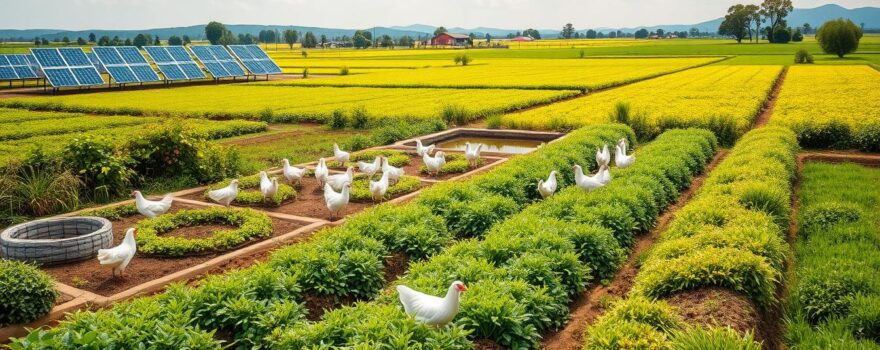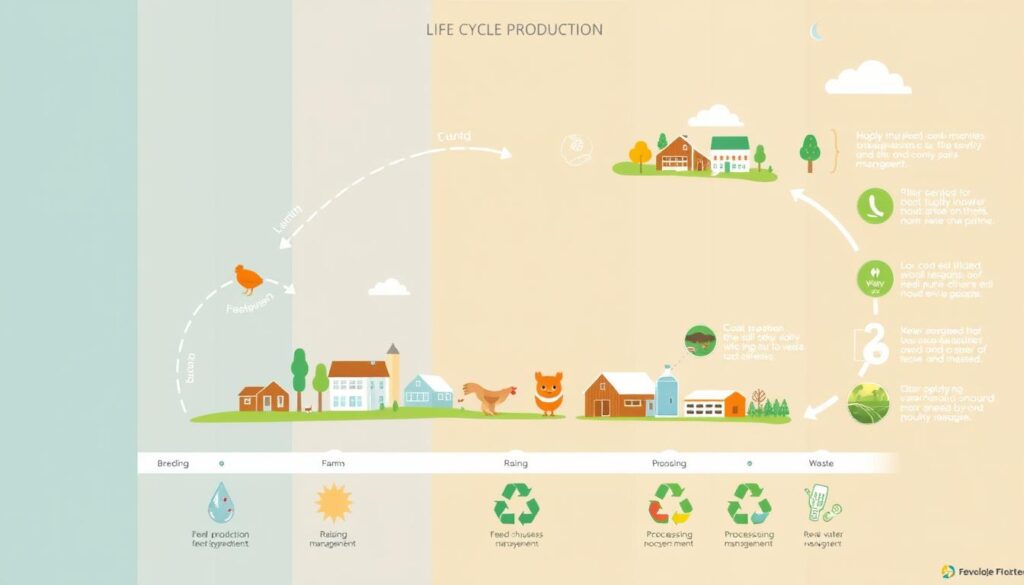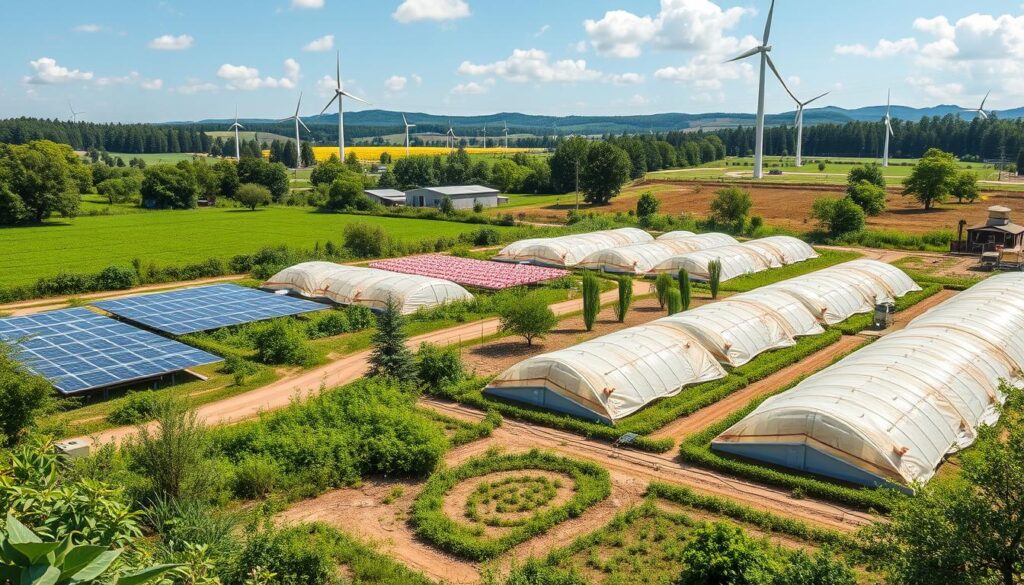
The poultry industry is changing fast. Broiler farmers in the U.S. must now reduce their environmental impact. This is key for following rules and keeping consumer trust.
This article will show you how to monitor and manage your farm’s environmental impact. You’ll learn to cut down your farm’s carbon footprint. This will also boost your farm’s productivity and profits.
Key Takeaways
- Understand the importance of environmental sustainability in broiler farming for economic, social, and ecological benefits.
- Implement strategies to improve broiler production efficiency, reduce greenhouse gas emissions, and optimize resource utilization.
- Assess the environmental life cycle of your broiler production and identify key areas for improvement.
- Adopt sustainable feed production practices and explore technological advancements to minimize the environmental footprint.
- Proactively manage air pollution, water conservation, and manure disposal to comply with environmental regulations and industry standards.
Understanding Environmental Sustainability in Broiler Farming
Environmental sustainability is key in modern broiler farming. It means managing natural resources well and reducing the farm’s environmental impact. This approach ensures the farm’s long-term success and benefits the community.
Definition and Importance of Environmental Sustainability
Environmental sustainability in broiler farming means using practices and tech that lessen the farm’s ecological footprint. It keeps the farm profitable and meets the growing demand for chicken. This includes saving water, cutting down on greenhouse gases, and using resources wisely.
Positive Economic and Social Impacts of Broiler Farming
Sustainable broiler farming is good for the environment and has big economic and social benefits. It makes farms more efficient and profitable. It also creates jobs, boosts local economies, and makes protein more affordable for everyone.
| Metric | Improvement from 1965 to Present |
|---|---|
| Environmental Impact | 50% reduction |
| Resource Utilization | 75% reduction |
| Greenhouse Gas Emissions | 36% reduction |
| Farmland Usage | 72% decrease |
| Water Consumption | 58% reduction |
These big improvements show the poultry industry’s dedication to sustainability. It’s great for the environment and the people who depend on it for food.
“The poultry industry has reduced the environmental impact by requiring 75% fewer resources.”
Improvements in Broiler Production Efficiency
The poultry industry has made big strides in making broiler production more efficient. Broiler farmers have found new ways to work smarter, use resources better, and cut down on environmental harm.
Productivity Gains and Resource Utilization
Genetic selection, better nutrition, and new housing have boosted broiler production. Now, a 5-pound broiler can grow in just 6 to 7 weeks, down from 12 weeks before. This change means broilers grow faster, eat less, and are more productive.
New tech like sensors, GPS, and data analytics has also helped. They help farmers keep an eye on things like air quality and feeding times. This leads to better growth and more efficient use of food. Robots and automation have also cut down on the need for manual labor, making farms run smoother.
Reduction in Greenhouse Gas Emissions and Water Consumption
The broiler industry is now more focused on being green. Better insulation, ventilation, and control systems have cut down on fuel use and improved air quality. Tunnel ventilation and cooling systems can even lower air temperature by up to 10 degrees Fahrenheit, saving energy.
Also, new tech and data-driven decisions have helped farmers use water better and waste less. Early disease detection and monitoring have also lowered death rates. This makes broiler farming more sustainable.
| Improvement | Impact |
|---|---|
| Genetic selection and nutrition advancements | Reduced broiler growth timeline from 12 to 6-7 weeks, increased meat yield, and better feed conversion |
| Precision agriculture technologies | Optimized environmental conditions, enhanced feed efficiency, and early disease detection |
| Robotics and automation | Reduced labor demands, improved operational efficiency, and better resource management |
| Improved insulation, ventilation, and climate control | Substantial fuel savings and enhanced temperature regulation in broiler houses |
These improvements have helped the industry save money and be more eco-friendly. They show how the poultry sector is moving towards more responsible farming practices.
How to Monitor and Manage the Environmental Impact of Your Broiler Farm
As a broiler farmer, it’s key to take steps to lessen your farm’s environmental impact. By looking at the environmental life cycle of broiler production, you can find ways to improve. This helps make your farm more sustainable.
Assessing Environmental Life Cycle of Broiler Production
Starting with a life cycle analysis (LCA) is vital. It looks at the environmental effects at every stage, from making feed to disposing of waste. This helps you see where you need to focus your efforts.
Identifying Key Areas for Improvement
- Feed Production: Look at the environmental effects of feed ingredients, how they’re transported, and stored. Find ways to make feed production more sustainable.
- Air Pollution: Check where air pollutants come from, like ammonia and greenhouse gases. Then, find ways to lessen these emissions.
- Water Usage: Study how much water you use and find ways to use it better. This includes treating and reusing wastewater.
- Waste Management: Create good plans for handling and disposing of manure. Look into composting and biogas production to reduce waste.
- Energy Efficiency: Find ways to use less energy in your broiler houses. This could include using renewable energy and improving lighting and ventilation.
By always checking and managing your farm’s environmental impact, you can reduce your ecological footprint. This not only helps the environment but also makes your farm more sustainable and profitable in the long run.

Feed Production and Environmental Footprint
Broiler feed production is key to the environmental impact of broiler farming. The environmental impact of broiler feed production is big. It includes growing, processing, and moving grains and other feed ingredients. It’s vital to tackle this impact for sustainable broiler farming.
Grain Selection and Local Sourcing
Choosing the right grains for broiler feed is crucial. Using locally sourced grains with a lower carbon footprint cuts down on emissions. It also makes the feed better and supports local sourcing of broiler feed.
Technological Advancements in Feed Production
New tech in broiler feed production boosts sustainability. Better feed processing and using new protein sources save resources and cut waste. Also, new ways to feed and formulate feed reduce environmental harm without losing productivity.
By focusing on grain selection, local sourcing, and new tech, broiler farmers can make a big difference. They can lower greenhouse gas emissions, use resources better, and have a smaller environmental footprint. All this helps keep broilers healthy and productive.
Mitigating Air Pollution in Broiler Farms
Air pollution is a big problem in broiler farms. The poultry industry releases harmful emissions that affect the environment and bird health. It’s important to know where these pollutants come from and how to manage air quality.
Sources of Air Pollution and Their Impact
Broiler farms release ammonia, particulate matter, and greenhouse gases like methane and nitrous oxide. Ammonia can harm bird health, especially at high concentrations. Even low levels can cause health problems.
These emissions also harm the environment. For example, they pollute the Chesapeake Bay, causing 24 million pounds of nitrogen pollution each year.
Strategies for Air Quality Management
- Improve production efficiency: Increase meat output to reduce emissions.
- Implement proper manure management: Manage manure to cut emissions and protect the environment.
- Utilize energy-efficient systems: Use energy-saving systems to lower emissions and fossil fuel use.
- Explore carbon sequestration: Use composting to help absorb greenhouse gases.
By tackling air pollution sources and using these strategies, broiler farmers can improve air quality. This helps reduce environmental harm and ensures a sustainable future for the industry.
| Country | Nitrogen Pollution from Poultry Industry (lbs) |
|---|---|
| Delaware | 2,235,420 |
| Maryland | 5,390,750 |
| New York | 140,618 |
| Pennsylvania | 10,016,049 |
| Virginia | 4,796,554 |
| West Virginia | 1,452,906 |
| Total | 24,032,297 |
Water Conservation in Broiler Houses
Managing water well is key in broiler farming. Broilers drink almost twice as much water as they eat. A five-pound broiler drinks about 18 pounds of water, compared to 10 pounds of food. Good water management saves water and makes farming more sustainable.
Efficient Water Management Practices
To manage water well in broiler houses, farmers need to follow some important steps:
- Keep the water flow right, aiming for 76ml per minute for eight-week-old broilers.
- Watch how much water broilers drink, as they drink more in hot weather to stay cool.
- Give them clean, slightly acidic water, as they prefer it and it affects how much they drink.
- Use the right amount of light to keep their water intake steady.
- Make sure the water system can handle the demand when it’s hot, with the right pump and pipes.
- Change the water filters often to keep the water flowing without interruptions.
Wastewater Treatment and Reuse
Broiler farms should also treat and reuse wastewater to save more water. Treating wastewater properly lets it be used for irrigation or cleaning. This cuts down the farm’s water use. By doing this, farms can lessen their environmental footprint and work more efficiently and sustainably.
| Water Management Best Practices | Benefits |
|---|---|
| Maintain adequate nipple flow rates | Ensures proper water access for broilers |
| Monitor water intake closely | Allows for adjustments to prevent heat stress |
| Provide clean, slightly acidic water | Encourages optimal water consumption |
| Optimize lighting for consistent water intake | Maintains stable water consumption patterns |
| Ensure reliable water supply system | Meets peak demand and prevents disruptions |
| Regular water filter monitoring and maintenance | Prevents clogging and ensures continuous water supply |
Manure Management for Environmental Sustainability
Proper manure management is key for broiler farming’s environmental health. A 30,000-layer farm can produce 40 tons of manure monthly, or 500 tons yearly. Good manure management cuts down on environmental risks and offers chances for nutrient cycling and waste reduction.
Nutrient Cycling and Waste Reduction
Manure is a valuable fertilizer for crops, saving farmers about $50 per acre. Planning nutrient management carefully helps use manure efficiently. This approach also lessens environmental harm.
Composting and Biogas Production
Broiler manure can be turned into compost and biogas, boosting environmental benefits. Composting makes organic matter stable, reducing waste and improving soil. Biogas production from manure also cuts down on non-renewable energy use.
| Manure Production | Nutrient Content | Manure Management Benefits |
|---|---|---|
|
|
|
By adopting best manure management practices, broiler farmers can make their operations more sustainable. They can also reduce waste and create valuable resources for their farms and the community.
Energy Efficiency in Broiler Production
Improving energy efficiency is key for sustainable broiler farming. Broiler production uses a lot of energy, with electricity and fuel being big costs. In fact, energy costs are second only to mortgage payments for contract poultry producers.
Renewable Energy Sources for Broiler Farms
Many farms are turning to renewable energy to meet their needs. Solar power is becoming popular for its clean and affordable benefits. Solar panels allow farmers to make their own electricity, cutting down on grid use and helping the planet.
Optimizing Lighting and Ventilation Systems
Improving existing systems is another way to save energy. Upgrading to LED bulbs and better ventilation systems can make a big difference. These changes help farmers use less energy and reduce their environmental footprint.
The University of Arkansas has studied energy use in broiler farms. They found electricity use varies a lot, from 20 to 83 kWh per 1,000 pounds of broilers sold. Switching to energy-efficient lamps is the most cost-effective way to cut down on electricity use.
Besides electricity, broiler farms use fuel for heating. Farms in northern counties use more fuel than those in southern counties. Farms can use less fuel by improving insulation and installing efficient fans.
By using renewable energy and improving their systems, broiler producers can make their farms more energy-efficient. This not only helps the environment but also makes their farms more sustainable.
Regulatory Compliance and Industry Standards
The broiler farming industry has to follow many environmental rules and standards. These rules help reduce the industry’s impact on the environment. Broiler farms must meet strict guidelines on how many birds they can keep and where they live. They also have to manage air emissions and waste properly.
Environmental Regulations and Certifications
Groups like the Department for Environment, Food, and Rural Affairs (DEFRA) and the RSPCA in the UK set the standards. They make sure farms follow rules on animal care, water use, and air pollution. Certifications like Hazard Analysis and Critical Control Points (HACCP) help farms manage environmental risks.
Best Practices for Sustainable Broiler Farming
- Maintain accurate records on bird genetics, veterinary care, nutrition, housing, and slaughter age for traceability
- Utilize phase-specific diets to enhance poultry welfare, meat quality, and growth efficiency
- Invest in sustainable farm infrastructure, such as renewable energy systems and effective waste management
- Implement robust biosecurity measures to prevent disease outbreaks and ensure flock health
- Optimize environmental conditions, including temperature, humidity, and ventilation, to support broiler growth and well-being
- Leverage data management and specialized software to streamline operations, improve efficiency, and enhance decision-making
Following environmental rules and best practices helps broiler farms reduce their impact. This way, they can meet consumer demand for sustainable poultry.

In this article, we looked at how to reduce the environmental impact of broiler farms. We talked about improving feed production and air quality. We also discussed saving water and handling manure better.
The main idea is to take a complete and active approach to sustainability in broiler farming. This way, we can make sure the industry is good for the planet.
Broiler farmers play a big role in making the industry green and lasting. They can use new tech like IoT and AI to work better and use less resources. This helps lower their carbon footprint.
As more people want chicken, it’s key for farmers to care for the environment. By using the tips from this article, farmers can help the poultry industry grow in a green way. This benefits the planet and the people around them.